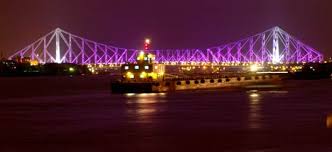
Kolkata's history is intimately related to the British East India Company, which first arrived in 1690, and to British India, of which Calcutta became the capital in 1772. Job Charnock was widely known as the founder of Calcutta (There were 3 villages named Sutanuti, Govindapur & Kolkata.Later the village Kolkata became the city Kolkata.) but in recent years a number of Indian historians have disputed this claim, arguing that Kolkata occupies the site of an older Indian city, centered around the ancient Kali temple at Kalighat. This claim has been accepted by the Kolkata High Court. The Court has dismissed the name of Job Charnock as the founder of the city and 24th August as its date of birth. The historic Judgement was based upon an high level Expert Commitee findings. It has been proved that Kolkata had an highly civilized society for centuries before the Europeans first came here.
Kolkata, the bustling capital city of West Bengal, is the hub of Bengali culture in India. The city which is the cultural capital of whole India and the commercial capital of Eastern India was earlier known as Calcutta as it was pronounced since the British rule and has changed to Kolkata officially in 2001. It has derived the name from Kalikata, which is a village name in the area before the British arrival, means the land of Goddess “Kali”. Kolkata boasts of a rich cultural heritage, evident in its distinct cuisine, clothing, lifestyle, its literature and even architecture

From the middle of the 19th Century attempts and experiments began to be made to establish a Municipal Corporation for Calcutta. It was felt that the city had grown and needed proper and specialised management to deal with its problems.Besides, now the "second city of the Empire" needed to have improved infrastructure,and systems to enable it to solve its own problems.
In 1847 the electoral system was introduced for the first time and the Justices were replaced by a Board of 7 paid members, four of whom were elected by the rate payers. The Board was authorised to purchase and hold property for improvement of the town, and to maintain roads and drains in proper state. In 1852, this Board was replaced by a new one of four members, of whom two were appointed by the Government and two were elected. Taxes were levied on housing, lighting, horses and vehicular traffic.

In 1863 a new body was formed which elected its own Vice Chairman, and had a regular Health Officer, Engineer, Surveyor, Tax Collector and Assessor. It was during this time that the drainage and water supply were largely developed. The New Market was established in 1874, and the Municipal Slaughter House in1866. Footpaths were made along with the main roads, and many other improvements carried out. The house tax was raised to a maximum of ten percent. In 1876 a new Corporation was created with 72 Commissioners. 48 of the Commissioners were elected by ratepayers and 24 appointed by the Government. At this time the two railway terminals at Howrah and Sealdah were connected by Harrison Road. Changes continued in 1888 and 1899. The most important changes were instituted by the Act of 1923, sponsored by Rashtraguru Surendranath Bannerjee as the first Minister for Local Self-Government in Bengal.
Modern Kolkata

Kolkata is the main business, commercial and financial hub of eastern India. Kolkata witnessed an economic decline from the late sixties till the late nineties. The city's economic fortunes turned the tide as the economic liberalization in India during the early nineties reached Kolkata during late nineties. Kolkata is a multicultural, cosmopolitan city. Apart from the diversity of India, there are also Europeans (including Germans, Armenians, and others) and other Asians (including Chinese, Sinhalese, and Tibetans).